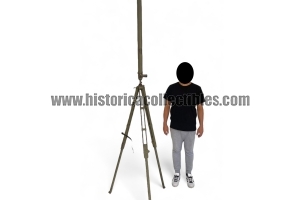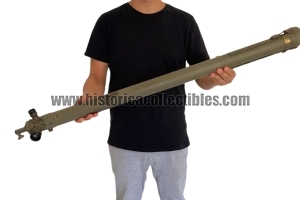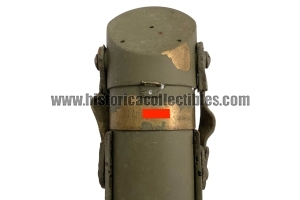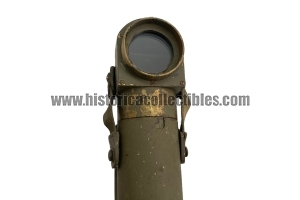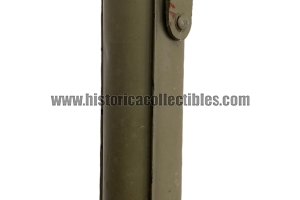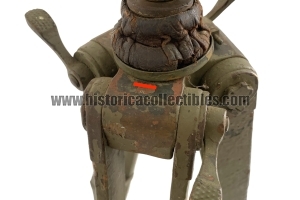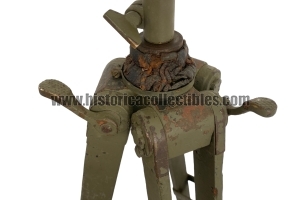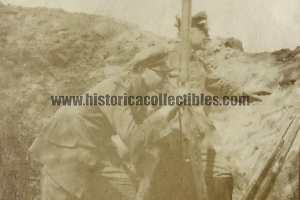Grabenperiskop Okularrevolver 10x-15x (113 cm), C.P. Goerz Berlin, Imperial German Army, circa 1914
Grabenperiskop or Trench Periscope with Carl Zeiss Jena tripod (marked "m"), with 10-15x42 revolver, produced by C.P. Goerz of Berlin in around 1914, to be intended for trench observers, used by the Imperial German Army or Kaiserreichsheer.
This trench periscope, which boasts a length of 113 cm excluding the tripod with which it is equipped, was designed and created by C.P. Goerz at the beginning of the First World War, with the aim of simplifying and making observation from the trenches safer compared to the more complicated and less manageable double scissor telescopes (Scherenfernrohre) as well as having decidedly shorter eyepiece tubes, making one more exposed to enemy fire the observer. Although it was not equipped with reticles, it proved to be very practical and efficient even for long-distance observation as, even though it was made up of a single tube, it was equipped with a "revolver" with two eyepieces, each equipped with 10x and 15x respectively. enlargements, which were easily selectable by simply rotating the revolver to the right or left, thus automatically locking once it reached its seat.
Of this model, three different versions are known which have 3 different length measurements.
Its aesthetic condition is excellent and it is perfectly functional in all its parts. It is also complete with its original sunshade.
C.P. Goerz was a company that built optical and photographic instruments, founded in Berlin in 1886 by Carl Paul Goerz (1854-1923), together with Carl Moser, an optical researcher, and Ottomar Anschutz, a laboratory technician in close friendships; precisely from this last C.P. In 1889, Goerz had purchased the patent for the construction of the first shutter for cameras capable of shutter speeds of 1/1000 of a second.
The company specialized in the production of lenses, cameras, telescopes and binoculars, including for military use. In 1886 it had around 25 employees, which rose to 2500 in 1911, although at its maximum expansion the workforce reached 10,000 employees.
In terms of size it was not even second to Zeiss (which in the same period had 1000 fewer workers), and it exported to many countries, including Russia and the United States. In 1905 Goerz American Optical continued to operate independently in the United States until 1972. In 1908 Goerz Photochemisches Werk GmbH was founded in Berlin, this section of the Goerz group produced film for photography and cinema.
Goerz had a fundamental relationship with the armies of the time and military supplies. In fact, it remained famous both for the large trench binoculars (First World War) and for the binoculars supplied to all the weapons of the Austrian-German Army (including navy and air force) as well as Bulgaria, Romania etc. Even today there are countless examples of Goerz binoculars that have value on the war and optical antiques market, one must think that in 1906 Goerz had already produced and exceeded 100,000 "Triëder" model binoculars, both for civil and military use.
In addition to the main and historic factory in Friedenau (Berlin), C.P. Goerz was also present in London, Paris and Vienna, Bratislava, Milan, Riga and St. Petersburg. Other sections were dedicated to chemical products and also for typewriters or calculating machines, which a division of the company was responsible for producing until 1945.
In 1910 the company bought the "Sendlinger Optische Galswerke" company founded by J. Von Fraunhofer and C. A. Steinheil for the production of optical glass and mirrors, which made it completely independent from purchasing from other retailers. After the First World War, with the Treaty of Versailles, the German companies that had produced war material were slowed down in production and this quickly led to a serious economic situation.
In 1923 Paul Goerz died and the company, which was in bankruptcy, was purchased by Zeiss which, together with the companies "Contessa", "Nettel", "ICA" and "Ernemann" founded Zeiss Ikon in 1926. The American division of Goertz became an independent company under the name Goertz American Optical Co. producing camera lenses and continuing their technical development. In 1971 it was bought by Kollmorgen, which was absorbed by Schneider Optics in 1972.

